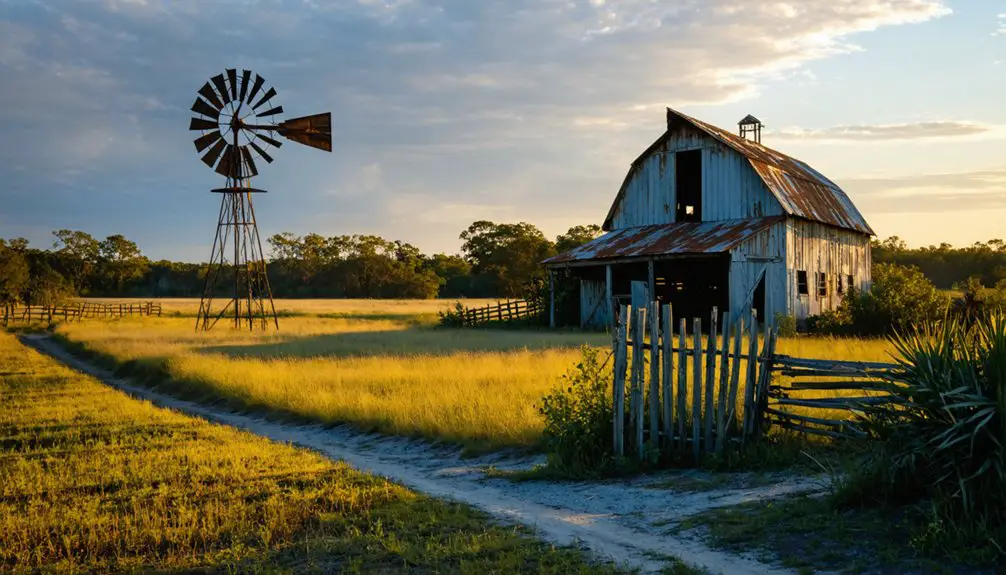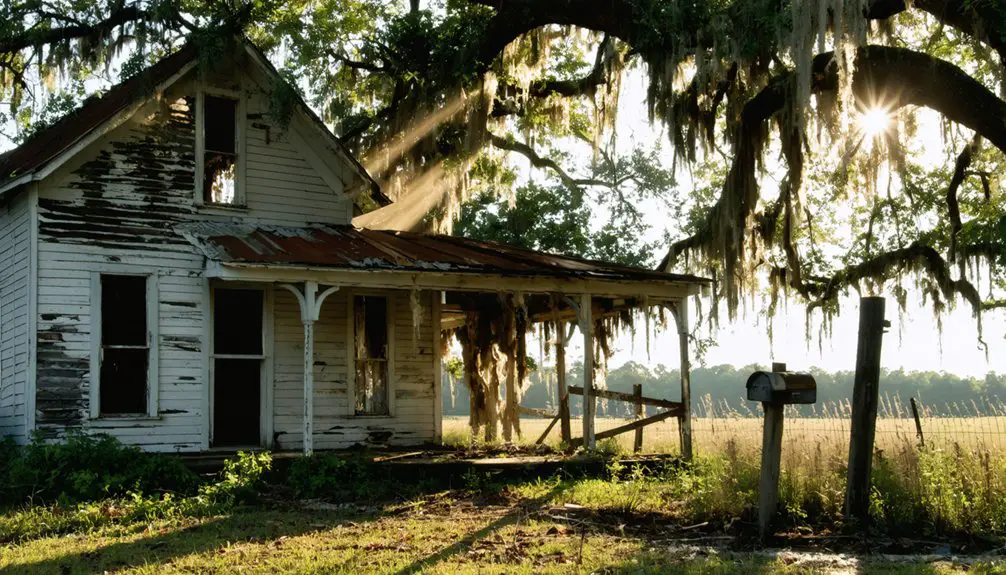Prairie Ridge, Florida’s short-lived frontier settlement, emerged in the early 1900s when the Southern Colonization Company divided 36 square miles of grassland into 10-acre farming parcels. You’ll find this ghost town‘s remains in what was once a hopeful agricultural community, supported by the South Florida and Gulf Railroad until 1918. Poor soil conditions and farming challenges forced settlers to abandon their dreams, though today’s Kissimmee Prairie Preserve State Park protects the settlement’s historical footprint.
Key Takeaways
- Prairie Ridge emerged as a 36-square-mile farming settlement in Florida but failed due to unsuitable soil conditions and agricultural challenges.
- The South Florida and Gulf Railroad’s abandonment in 1918 isolated the community, accelerating its decline into a ghost town.
- Early settlers built scattered farmsteads and basic wood-frame houses, but lack of community facilities hindered social development.
- Myakka Fine Sand’s poor farming conditions and nutrient deficiencies led to widespread crop failures and eventual abandonment.
- The site is now preserved through Kissimmee Prairie Preserve State Park, with hiking trails marking the settlement’s former location.
The Birth of a Prairie Dream
As the 20th century dawned, the Southern Colonization Company set its sights on Florida’s untamed prairie, purchasing 36 square miles of grassland that would become Prairie Ridge.
You can imagine the optimism of those Midwestern businessmen as they carved up their subtropical acquisition into tidy 10-acre parcels, each one promising a fresh start for ambitious settlers.
The settler dreams were simple yet bold: transform this wild prairie into a thriving agricultural community.
You’d have found rich grasslands stretching to the horizon, with soil that seemed to hold such promise.
Like many boom-and-bust settlements of the era, Prairie Ridge’s fortunes would prove fleeting.
Yet these pioneers would soon face prairie challenges they hadn’t anticipated. The land, while lush with native flora and perfect for grazing, would prove less accommodating to their farming ambitions than they’d hoped.
In 1915, they commissioned the construction of the South Florida and Gulf Railroad to connect their fledgling community to the wider world.
Land Developers and Their Grand Vision
While the Southern Colonization Company laid claim to Florida’s untamed grasslands, their vision extended far beyond mere land ownership. You’d have witnessed their developer aspirations unfold as they carved out 36 square miles near Prairie Ridge into 10-acre parcels, each promising agricultural prosperity to enthusiastic settlers.
The Hunter Land Company’s marketing strategies proved innovative yet calculated. They’d shuttle potential buyers via river steamer to view their demonstration farm and hotel at Hunters Camp. The farming viability proved poor, causing many development projects to ultimately fail. Modern developers like Prairie Ridge Development Group have found more success by focusing on industrial and mixed-use projects instead of agricultural ventures.
You’d have heard their ambitious promises of railroad connections and thriving markets, culminating in the construction of the South Florida and Gulf Railroad by 1916. These Midwestern businessmen painted a picture of modern convenience and farming success, though they’d soon discover Florida’s prairie held different plans for their grand development schemes.
Railroad Brings Hope to the Settlement
When the South Florida and Gulf Railroad first laid tracks in 1915, Prairie Ridge’s settlers saw their dreams of agricultural prosperity taking shape. The Southern Colonization Company‘s 29-mile rail line connected their remote settlement to Kenansville and the Florida East Coast Railway, promising a lifeline to broader markets and civilization.
The railroad’s impact on settlement aspirations manifested in three key ways:
- Weekly train service transported essential supplies and farm products.
- Direct access to Florida’s major rail networks opened trade possibilities.
- Infrastructure development attracted hopeful homesteaders and investors.
You’d have witnessed a surge of optimism as settlers believed the railroad would transform Prairie Ridge into a thriving agricultural hub. Wagon teams from Basinger helped move supplies from the depot to their final destinations.
However, the unsuitable farming conditions and limited service ultimately couldn’t sustain the community’s ambitious vision, leading to the line’s abandonment by 1918.
Life in Early Prairie Ridge
The stark reality of Prairie Ridge’s early settlement stood in sharp contrast to the railroad’s promise of prosperity.
You’d find scattered farmsteads with basic wood-frame houses, where families struggled to cultivate stubborn soil on their 10-acre plots. Community dynamics were sparse – there weren’t any churches, schools, or gathering places to bring settlers together. Like many settlements documented in Map CCA101810, the area lacked proper educational facilities. The settlers, primarily pioneers from Georgia and neighboring states, brought their agricultural traditions with them.
Daily hardships defined life here. You’d need to trek to Basinger for basic supplies, traversing sandy trails by wagon. The weekly train service offered your only real connection to the outside world.
Most families attempted farming, but the wet prairie land fought back against crop production. While some shifted to cattle grazing, the isolation and poor agricultural prospects eventually forced many to abandon their frontier dreams.
Agricultural Struggles on Florida Soil
Since Prairie Ridge’s soil presented unique challenges, you’d find settlers battling against Florida’s notorious Myakka Fine Sand – a nutrient-poor foundation for farming dreams.
Early farmers struggled with nutrient management as their crops withered in the sandy soil, watching helplessly as fertilizers leached away with each rainfall. Studies by S.E. Collison in the 1910s helped explain why Florida’s sandy soils were so prone to nutrient loss. Like the pioneers of Lake Worth shores, these early settlers faced immense agricultural hardships while trying to establish viable farms.
- They fought soil erosion and acidic conditions by spreading hardwood ashes across their fields.
- They implemented drainage systems to combat waterlogging in low-lying areas.
- They planted cover crops like crotalaria to naturally enrich the depleted soil.
You’d see these determined homesteaders mixing legumes with other cover crops, desperately trying to build up organic matter in their fields.
Despite their innovative efforts to improve the land’s fertility, many ultimately abandoned their farms, unable to overcome Florida’s challenging soil conditions.
The Railroad’s Final Whistle
During 1915’s optimistic expansion of Florida’s railways, you’d find the Southern Colonization Company laying tracks for their ambitious South Florida and Gulf Railroad – a 29-mile line connecting Prairie Ridge to Kenansville’s Florida East Coast Railway junction.
The railroad’s history proved tragically brief. While you could catch the weekly train, usually on Saturdays, to transport supplies and access markets, the line’s economic impact fell far short of expectations. Like the Florida Southern Railway decades before, the region’s rail lines faced persistent financial struggles.
The unsuitable farming conditions meant fewer settlers, less cargo, and dwindling profits. By 1918, just three years after its construction, the railroad’s final whistle echoed across the prairie. The tracks were sold at a loss and removed, leaving behind only the sandy Peavine Trail that now winds through Kissimmee Prairie Preserve State Park – a reflection of Florida’s speculative railroad dreams.
From Farmland to Ghost Town

Founded in 1910 by ambitious Midwestern businessmen, Prairie Ridge emerged as a speculative farming venture when the Southern Colonization Company acquired 36 square miles of Florida prairie.
You’ll find that settler experiences quickly revealed the harsh realities of the land’s limitations, as soil conditions proved better suited for grazing than crop farming.
The economic challenges facing Prairie Ridge’s residents included:
Economic hardship plagued Prairie Ridge settlers as they battled failing crops, limited farming options, and devastating railroad closure.
- Failed attempts at traditional row crop cultivation
- Limited success with subtropical agriculture and citrus
- Isolation after the railroad’s closure in 1918
The community’s swift decline became inevitable as farms failed and infrastructure crumbled.
When the railroad was sold at a loss and converted to a simple sand road, Prairie Ridge’s remaining settlers departed, leaving their dreams of agricultural prosperity behind in what would become another Florida ghost town.
Preserving Prairie Ridge’s Legacy
You’ll find Prairie Ridge’s rich history preserved within Kissimmee Prairie Preserve State Park, where remnants of old structures and agricultural infrastructure tell the story of this former settlement.
The park’s conservation efforts focus on protecting both historic sites and native prairie landscapes, while managing challenges like soil erosion and structural decay.
You can explore the town’s past by walking the Peavine Trail, which follows the old railroad right-of-way and features interpretive signage about Prairie Ridge’s significance as a ghost town.
Historical Site Conservation
While Prairie Ridge’s original structures have largely succumbed to time, conservation efforts within Kissimmee Prairie Preserve State Park now focus on protecting what remains of this early 20th-century settlement.
You’ll find conservation challenges throughout the site, where historical artifacts face ongoing threats from natural decay and weathering. The park’s preservation team implements careful strategies to safeguard these precious remnants of Florida’s pioneering past.
- Archaeological surveys continue to uncover subsurface remains that help reconstruct the town’s original layout.
- Non-invasive conservation techniques protect both historical structures and the surrounding prairie ecosystem.
- Collaborative efforts between park authorities, historical societies, and volunteers maintain the site’s cultural significance.
Walking Trail Initiatives
Beyond the preserved ruins of Prairie Ridge, an innovative trail system now breathes new life into the ghost town’s historical footprint.
You’ll find the Peavine Trail tracing the abandoned South Florida and Gulf Railroad line, offering trail accessibility through a sand road that connects local parks and preserves.
Community engagement flourishes as regional trail associations maintain these paths, encouraging heritage tourism and outdoor recreation.
You can explore educational markers that tell Prairie Ridge’s story while hiking or biking through restored natural habitats.
The trail network integrates seamlessly with Florida’s broader hiking systems, including the Western Corridor and Croom Hiking Trail.
Frequently Asked Questions
What Happened to the Original Settlers After Prairie Ridge Was Abandoned?
You’ll find settler migration patterns led families to nearby Florida towns or back to the Midwest, seeking better prospects after failed farming attempts, though ghost town legends suggest some stayed regionally connected.
Were There Any Deaths or Accidents During the Railroad’s Operation?
You’ll find no confirmed deaths at Prairie Ridge’s railroad, though Florida saw major accidents nearby. While local folklore hints at ghost sightings along the tracks, there’s no official record of fatalities there.
What Was the Total Population of Prairie Ridge at Its Peak?
You won’t find exact population records, but considering the historical significance and rapid population decline, estimates suggest Prairie Ridge likely peaked at no more than 200-300 residents around 1915.
Did Any Businesses Besides Farms Operate in Prairie Ridge?
Ever wonder what drew people to such remote places? You won’t find records of any grocery stores or blacksmith shops – Prairie Ridge’s only businesses were its struggling farms and the short-lived railroad depot.
Were There Any Schools or Churches Built in Prairie Ridge?
You won’t find any school history or church architecture in the records – there’s no evidence that either type of building was ever constructed during Prairie Ridge’s brief existence in the 1910s.
References
- https://www.frrandp.com/2020/06/prairie-ridge-florida-and-south-florida.html
- https://cccourthouse.org/wp-content/uploads/2023/12/Ghost-towns-and-Cemeteries-of-Citrus-County.pdf
- https://www.pinterest.com/pin/270356783855715398/
- https://en.wikipedia.org/wiki/List_of_ghost_towns_in_Florida
- https://www.ghosttowns.com/states/fl/prairieridge.html
- https://www.lamartin.com/history/history_of_okeechobee_county/chapter2.htm
- https://www.prairieridgedev.com/about
- https://digitalcommons.usf.edu/cgi/viewcontent.cgi?article=1308&context=sunlandtribune
- https://fdotwww.blob.core.windows.net/sitefinity/docs/default-source/environment/pubs/cultural-resources/floridas-historic-railroad-resources-mps_nrhplisted04052001_ms6289.pdf?sfvrsn=42f8a61f_2
- https://dash.harvard.edu/bitstreams/7b9056e7-cc8c-4e08-9e88-904b6b9d5a5e/download



